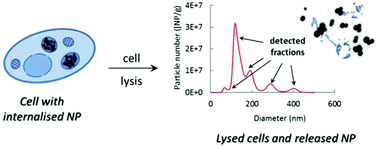Changes in silica nanoparticles upon internalisation by cells: size, aggregation/agglomeration state, mass- and number-based concentrations†
Abstract
Monitoring the physicochemical characteristics of nanoparticles following internalisation by cells is a vital step in understanding their biological impact and toxicity. Here, the feasibility of a methodology utilising gentle enzymatic lysis of cells containing internalised particles and direct analysis of the lysates for the particle size, agglomeration state and concentration, is investigated. It is demonstrated that following internalisation, all types of studied silica particles partially agglomerate/aggregate, with the degree and rate of the observed transformation closely correlated with the initial particle surface chemistry. Several different particle populations are noted and characterised in terms of their size and concentration. Good agreement between different complementary techniques is reached in terms of the average particle diameter. Particle concentration is determined here with techniques capable of mass and number-based measurements, with limitations of approaches utilising signal conversion to equivalent particle numbers identified and discussed.



 Please wait while we load your content...
Please wait while we load your content...